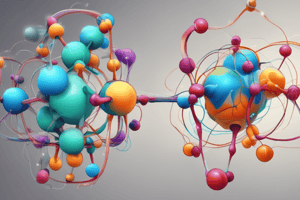Podcast
Questions and Answers
What type of bond is formed when two atoms share electrons unequally?
What type of bond is formed when two atoms share electrons unequally?
- Hydrogen bond
- Ionic bond
- Polar covalent bond (correct)
- Covalent bond
What is the main difference between ionic and covalent bonds?
What is the main difference between ionic and covalent bonds?
- The type of atoms involved
- The way electrons are shared or transferred (correct)
- The number of electrons involved
- The strength of the bond
What is the term for the energy required to break a bond?
What is the term for the energy required to break a bond?
- Bond strength (correct)
- Bond energy
- Bond polarity
- Bond length
What is the main principle behind the VSEPR theory?
What is the main principle behind the VSEPR theory?
What type of bond typically forms between metals and non-metals?
What type of bond typically forms between metals and non-metals?
What determines the physical properties of a substance?
What determines the physical properties of a substance?
What is the term for the weak bond between a hydrogen atom bonded to a highly electronegative atom and another electronegative atom?
What is the term for the weak bond between a hydrogen atom bonded to a highly electronegative atom and another electronegative atom?
What do metalloids exhibit in terms of bonding?
What do metalloids exhibit in terms of bonding?
Flashcards are hidden until you start studying
Study Notes
Types of Chemical Bonds
- Ionic Bond: formed between two atoms that have a large difference in electronegativity, resulting in the transfer of one or more electrons. One atom loses an electron(s) to become a positively charged ion (cation), while the other atom gains an electron(s) to become a negatively charged ion (anion).
- Covalent Bond: formed between two atoms that share one or more pairs of electrons. This type of bond typically occurs between non-metal atoms.
- Polar Covalent Bond: a type of covalent bond that occurs when two atoms share electrons unequally, resulting in a partial positive charge on one atom and a partial negative charge on the other.
- Hydrogen Bond: a weak bond between a hydrogen atom bonded to a highly electronegative atom (such as oxygen, nitrogen, or fluorine) and another electronegative atom.
Bonding Theories
- Valence Shell Electron Pair Repulsion (VSEPR) Theory: predicts the shape of molecules based on the arrangement of electron pairs around the central atom.
- Molecular Orbital (MO) Theory: describes the distribution of electrons in a molecule in terms of molecular orbitals.
Bond Characteristics
- Bond Length: the distance between the nuclei of two bonded atoms.
- Bond Strength: the energy required to break a bond.
- Bond Polarity: the distribution of electrons within a bond, resulting in a partial positive or negative charge on the atoms involved.
Bonding in Different Substances
- Metals: typically form ionic bonds with non-metals, but can also form metallic bonds with other metals.
- Non-metals: typically form covalent bonds with other non-metals.
- Metalloids: exhibit intermediate properties between metals and non-metals, and can form both ionic and covalent bonds.
Importance of Chemical Bonding
- Determines Physical Properties: such as melting and boiling points, solubility, and conductivity.
- Determines Chemical Properties: such as reactivity and acidity.
- Essential for Life: chemical bonding plays a crucial role in biological processes, such as protein structure and function.
Types of Chemical Bonds
- Ionic bonds form between atoms with a large electronegativity difference, resulting in electron transfer and the creation of ions.
- Covalent bonds form between non-metal atoms, involving the sharing of one or more pairs of electrons.
- Polar covalent bonds occur when atoms share electrons unequally, resulting in partial positive and negative charges.
- Hydrogen bonds are weak bonds between a hydrogen atom bonded to a highly electronegative atom and another electronegative atom.
Bonding Theories
- Valence Shell Electron Pair Repulsion (VSEPR) Theory predicts molecular shapes based on electron pair arrangements around the central atom.
- Molecular Orbital (MO) Theory describes electron distribution in molecules in terms of molecular orbitals.
Bond Characteristics
- Bond length is the distance between the nuclei of two bonded atoms.
- Bond strength is the energy required to break a bond.
- Bond polarity is the distribution of electrons within a bond, resulting in partial positive or negative charges.
Bonding in Different Substances
- Metals typically form ionic bonds with non-metals, but can also form metallic bonds with other metals.
- Non-metals typically form covalent bonds with other non-metals.
- Metalloids exhibit intermediate properties and can form both ionic and covalent bonds.
Importance of Chemical Bonding
- Chemical bonding determines physical properties such as melting and boiling points, solubility, and conductivity.
- Chemical bonding determines chemical properties such as reactivity and acidity.
- Chemical bonding is essential for life, playing a crucial role in biological processes like protein structure and function.
Studying That Suits You
Use AI to generate personalized quizzes and flashcards to suit your learning preferences.




